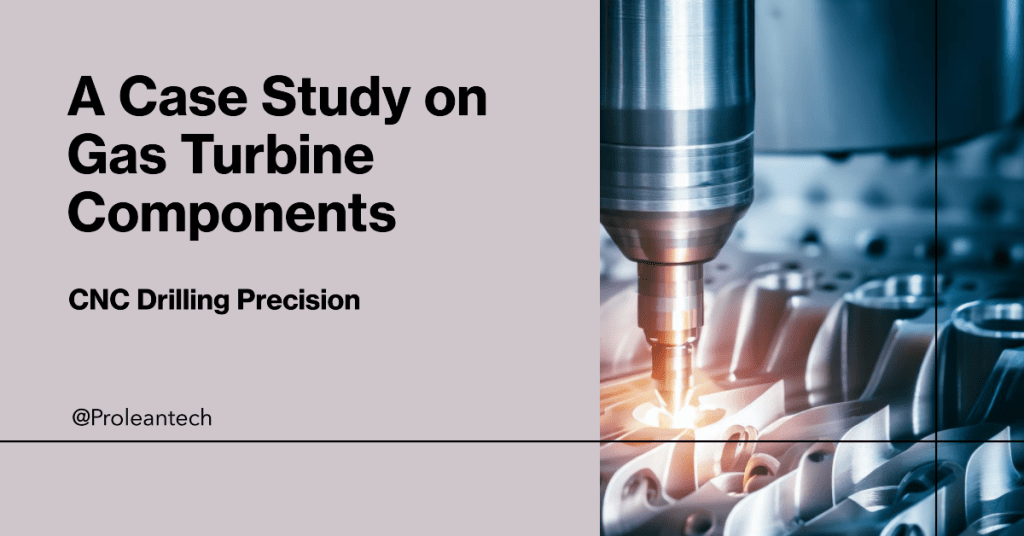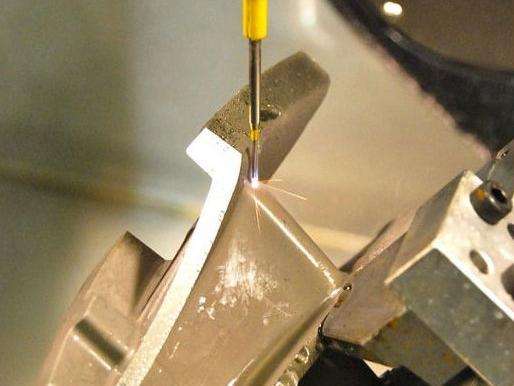
CNC drilling on turbine part
CNC drilling, known for its precision and efficiency, has revolutionized manufacturing across various industries. Its impact is especially profound in the production of complex, high-precision components such as those found in gas turbines.
Gas turbines, used in power generation and aviation, are made up of many intricate parts that require high levels of accuracy. Traditional drilling methods often struggle to meet the stringent dimensional tolerances and surface finish requirements of these components. Furthermore, manual drilling processes can be time-consuming and prone to human error, leading to inconsistencies and defects that can compromise the performance and reliability of the turbine.
This article delves into a specific case study, showcasing the transformative power of CNC drilling in the manufacturing of gas turbine components.
I. Understanding Gas Turbine Components

Gas turbine components are complex and highly engineered parts, each designed with a specific function to ensure the efficient operation of the turbine. The components are typically manufactured from high-performance materials to withstand the high temperatures and pressures they are subjected to. To understand the scope of CNC drilling in the production of these components, let’s take a closer look at some of the key parts:
- Combustor: The combustor is where the fuel-air mixture is ignited, producing high-temperature, high-pressure gas. It’s usually made of heat-resistant materials and requires precision-drilled holes for fuel injection and cooling airflow.
- Turbine Blades: Turbine blades extract energy from the high-pressure gas produced in the combustor. They have cooling channels drilled into them to prevent overheating, a task that requires the utmost precision.
- Nozzle Guide Vanes: These are stationary blades that direct the gas flow onto the turbine blades. They also have cooling holes drilled into them.
- Disk and Shaft: These components transmit the rotational energy from the turbine blades to the generator (in power plants) or the propellers (in aircraft). They require drilled holes for balancing and assembly purposes.
Each of these components has a specific set of requirements, including dimensional tolerances, surface finish, and hole placement, which pose significant challenges in their production. Next, we’ll discuss these challenges and how CNC drilling has addressed them.
II. Requirement of Precision in Gas Turbine Components
The dimensional requirements for gas turbine components are exceptionally tight due to the precision needed for efficient turbine operation. For instance, the holes drilled into turbine blades for cooling purposes need to be of a precise diameter, typically in the range of 0.5 to 1.0 millimeters. They also need to be positioned accurately, often with tolerances of just a few micrometers. Moreover, the depth of these holes is also critical as it determines the amount of cooling air that can flow through them.
Additionally, the surface finish of these holes is equally important. A smooth surface finish ensures optimal airflow, minimizing turbulence which can affect cooling efficiency and potentially lead to overheating of the components.
Meeting these dimensional requirements poses significant challenges, especially given the volume of parts that need to be produced for each turbine. This is where CNC drilling comes into play, providing the precision, consistency, and speed needed to meet these demanding specifications. In the following sections, we’ll discuss the problems encountered during the drilling of gas turbine components and how CNC drilling offers solutions to these challenges.
III. The Challenges of Traditional Drilling
Traditional drilling methods often fall short when it comes to manufacturing gas turbine components, mainly due to the tough material and strict dimensional requirements. Here are some of the key challenges:
- Tool Wear and Breakage: High-temperature super alloys are notoriously difficult to machine. Their high hardness and work-hardening characteristics can lead to rapid tool wear and breakage, resulting in inconsistent hole dimensions and increased production downtime.
- Inconsistent Hole Quality: Manual drilling methods often struggle to maintain consistent hole diameter, depth, and surface finish, especially when working with tough materials and high production volumes. This can lead to components that don’t meet the required specifications, resulting in increased scrap rates and costs.
- Limited Speed and Scalability: Traditional drilling methods are relatively slow and don’t scale well with high production volumes. This can lead to longer production times and higher costs, especially when manufacturing complex components like gas turbine blades.
CNC Drilling: The Solution for Precision and Efficiency
CNC drilling offers a solution to these challenges, providing the precision, consistency, and speed needed for manufacturing gas turbine components. Here’s how:
| Advantages of CNC Drilling | Description |
|---|---|
| Improved Tool Life | Optimal feeds and speeds can reduce tool wear and breakage. Tool monitoring systems can replace worn tools automatically. |
| Consistent Hole Quality | Precise computer-generated instructions ensure consistent hole diameter, depth, and surface finish, meeting strict dimensional requirements. |
| Increased Speed and Scalability | High speeds reduce drilling times. Machines can run unattended for extended periods, allowing for high-volume production with minimal intervention. |
| Flexibility | Machines can be quickly reprogrammed to accommodate different part designs for varying production needs. |
By overcoming the challenges of traditional drilling, CNC drilling delivers the precision and efficiency required for producing high-quality gas turbine components. In the next section, we’ll take a closer look at a case study where CNC drilling was employed to manufacture gas turbine components.
Implementing CNC Drilling for Gas Turbine Component Production
To fully understand the capabilities and benefits of CNC drilling, we delve into a real-world application. A manufacturer of gas turbine components was grappling with production delays and quality inconsistencies, primarily due to excessive tool wear and dimensional deviations in the drilling process. In particular, they were manufacturing turbine blades, a component that requires high precision due to their critical role in the turbine’s operation.
To address these issues, the manufacturer enlisted Prolean’s CNC drilling services. Our team started by thoroughly reviewing the component drawings and understanding the unique properties of the Inconel superalloy used in the blade. Based on this analysis, we developed an optimal drilling program tailored to these specific requirements.
Requirements
| Specifications | Value |
|---|---|
| Cooling Hole Diameter | 3mm |
| Cooling Hole Depth Tolerance | +/- 0.05mm |
| Dovetail Slot Tolerance | +/- 0.02mm |
| Material | Inconel super-alloy |
| Tool Used | Carbide drill bit |
Machine Set-up and Drilling
Next, we chose an appropriate tool for the job: a carbide drill bit known for its excellent hardness and toughness, ideal for machining difficult-to-cut materials like Inconel. This selection significantly reduced tool wear, ensuring consistent hole dimensions throughout the production run.
We then set our advanced CNC drilling machine to work. The precision that our machine offered was instrumental in achieving the stringent tolerances required for the cooling holes and dovetail slots. Each hole was drilled to the exact depth and diameter, with a surface finish that met the component’s specifications. The dovetail slots were also machined to precise dimensions, ensuring a perfect fit during assembly.
Result
It demonstrates how CNC drilling can deliver the precision and efficiency necessary for producing high-quality gas turbine components. It also highlights the role that expert services like Prolean’s can play in helping manufacturers overcome production challenges and achieve their quality goals.
Prolean’s CNC Drilling Service: Your Partner for High-Precision Drilling
As seen in this case study, Prolean’s CNC drilling services can help you overcome the challenges of precision drilling and unlock the full potential of your manufacturing process. At Prolean, we combine advanced CNC technology with extensive machining expertise to deliver high-quality, efficient, and flexible drilling solutions. Whether you’re producing gas turbine components or other high-precision parts, we’re ready to help you achieve success with each drilled hole.
Conclusion
This case study demonstrates the transformative power of CNC drilling in the manufacturing of high-precision gas turbine components. By overcoming the challenges of traditional drilling methods, CNC drilling not only improved the quality and efficiency of the production process but also opened up new opportunities for optimization and scalability.
The manufacturer’s experience serves as a testament to the flexibility and potential of CNC drilling, showing how it can be leveraged to meet the demands of modern manufacturing and pave the way for future innovations.
FAQs
1 How does CNC drilling improve the precision of gas turbine component manufacturing?
CNC drilling improves precision by eliminating human error in the drilling process. The location, depth, and diameter of each hole are programmed into a computer, ensuring each hole is drilled exactly as specified.
2 How does CNC drilling improve efficiency in the production of gas turbine components?
CNC drilling improves efficiency by automatically adjusting the drilling speed and feed rate based on the material properties. This reduces tool wear and allows faster drilling times.
3 Can CNC drilling be used for other high-precision manufacturing applications?
Yes, CNC drilling is versatile and can be used for a wide range of high-precision manufacturing applications, from automotive parts to medical devices.
4 What is the difference between CNC drilling and traditional drilling?
CNC drilling uses computer-controlled machines to automate the drilling process, resulting in higher precision and efficiency. Traditional drilling is performed manually, making it more prone to human error and slower.
5 How does CNC drilling improve the quality of gas turbine components?
CNC drilling improves the quality of gas turbine components by ensuring that each hole is drilled to precise dimensions and surface finish. This minimizes defects and inconsistencies, resulting in components that meet strict dimensional requirements and perform optimally.




0 Comments